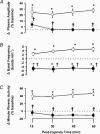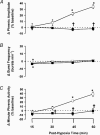Phrenic long-term facilitation requires NMDA receptors in the phrenic motonucleus in rats
- PMID: 15932891
- PMCID: PMC1474185
- DOI: 10.1113/jphysiol.2005.087650
Phrenic long-term facilitation requires NMDA receptors in the phrenic motonucleus in rats
Abstract
Exposure to episodic hypoxia induces a persistent augmentation of respiratory activity, known as long-term facilitation (LTF). LTF of phrenic nerve activity has been reported to require serotonin receptor activation and protein syntheses. However, the underlying cellular mechanism still remains poorly understood. NMDA receptors play key roles in synaptic plasticity (e.g. some forms of hippocampal long-term potentiation). The present study was designed to examine the role of NMDA receptors in phrenic LTF and test if the relevant receptors are located in the phrenic motonucleus. Integrated phrenic nerve activity was measured in anaesthetized, vagotomized, neuromuscularly blocked and artificially ventilated rats before, during and after three episodes of 5 min isocapnic hypoxia (P(a,O2) = 30-45 mmHg), separated by 5 min hyperoxia (50% O2). Either saline (as control) or the NMDA receptor antagonist MK-801 (0.2 mg kg(-1), i.p.) was systemically injected approximately 1 h before hypoxia. Phrenic LTF was eliminated by the MK-801 injection (vehicle, 32.8 +/- 3.7% above baseline in phrenic amplitude at 60 min post-hypoxia; MK-801, -0.5 +/- 4.1%, means +/- S.E.M.), with little change in both the CO2-apnoeic threshold and the hypoxic phrenic response (HPR). Vehicle (saline, 5 x 100 nl) or MK-801 (10 microM; 5 x 100 nl) was also microinjected into the phrenic motonucleus region in other groups. Phrenic LTF was eliminated by the MK-801 microinjection (vehicle, 34.2 +/- 3.4%; MK-801, -2.5 +/- 2.8%), with minimal change in HPR. Collectively, these results suggest that the activation of NMDA receptors in the phrenic motonucleus is required for the episodic hypoxia-induced phrenic LTF.
Figures





Similar articles
-
Spinal NMDA receptor activation is necessary for de novo, but not the maintenance of, A2a receptor-mediated phrenic motor facilitation.J Appl Physiol (1985). 2009 Jul;107(1):217-23. doi: 10.1152/japplphysiol.00183.2009. Epub 2009 Apr 30. J Appl Physiol (1985). 2009. PMID: 19407255
-
Episodic phrenic-inhibitory vagus nerve stimulation paradoxically induces phrenic long-term facilitation in rats.J Physiol. 2003 Sep 15;551(Pt 3):981-91. doi: 10.1113/jphysiol.2003.048157. Epub 2003 Jul 18. J Physiol. 2003. PMID: 12872010 Free PMC article.
-
Formation and maintenance of ventilatory long-term facilitation require NMDA but not non-NMDA receptors in awake rats.J Appl Physiol (1985). 2008 Sep;105(3):942-50. doi: 10.1152/japplphysiol.01274.2006. Epub 2008 Jun 26. J Appl Physiol (1985). 2008. PMID: 18583381 Free PMC article.
-
NADPH oxidase activity is necessary for acute intermittent hypoxia-induced phrenic long-term facilitation.J Physiol. 2009 May 1;587(Pt 9):1931-42. doi: 10.1113/jphysiol.2008.165597. Epub 2009 Feb 23. J Physiol. 2009. PMID: 19237427 Free PMC article. Review.
-
Long term facilitation of phrenic motor output.Respir Physiol. 2000 Jul;121(2-3):135-46. doi: 10.1016/s0034-5687(00)00124-9. Respir Physiol. 2000. PMID: 10963770 Review.
Cited by
-
Competing mechanisms of plasticity impair compensatory responses to repetitive apnoea.J Physiol. 2019 Aug;597(15):3951-3967. doi: 10.1113/JP277676. Epub 2019 Jul 7. J Physiol. 2019. PMID: 31280489 Free PMC article.
-
Acute intermittent hypoxia enhances corticospinal synaptic plasticity in humans.Elife. 2018 Apr 24;7:e34304. doi: 10.7554/eLife.34304. Elife. 2018. PMID: 29688171 Free PMC article.
-
In hamsters dopamine D2 receptors affect ventilation during and following intermittent hypoxia.Comp Biochem Physiol A Mol Integr Physiol. 2007 Nov;148(3):674-80. doi: 10.1016/j.cbpa.2007.08.020. Epub 2007 Aug 28. Comp Biochem Physiol A Mol Integr Physiol. 2007. PMID: 17884646 Free PMC article.
-
Shedding light on restoring respiratory function after spinal cord injury.Front Mol Neurosci. 2009 Oct 30;2:18. doi: 10.3389/neuro.02.018.2009. eCollection 2009. Front Mol Neurosci. 2009. PMID: 19893756 Free PMC article.
-
Axon plasticity in the mammalian central nervous system after injury.Trends Neurosci. 2014 Oct;37(10):583-93. doi: 10.1016/j.tins.2014.08.008. Epub 2014 Sep 10. Trends Neurosci. 2014. PMID: 25218468 Free PMC article. Review.
References
-
- Aboubakr SE, Taylor A, Ford R, Siddiqi S, Badr MS. Long-term facilitation in obstructive sleep apnea patients during NREM sleep. J Appl Physiol. 2001;91:2751–2757. - PubMed
-
- Babcock MA, Badr MS. Long-term facilitation of ventilation in humans during NREM sleep. Sleep. 1998;21:709–716. - PubMed
-
- Babcock M, Shkoukani M, Aboubakr SE, Badr MS. Determinants of long-term facilitation in humans during NREM sleep. J Appl Physiol. 2003;94:53–59. - PubMed
-
- Bach KB, Mitchell GS. Hypoxia-induced long-term facilitation of respiratory activity is serotonin dependent. Respir Physiol. 1996;104:251–260. - PubMed
Publication types
MeSH terms
Substances
Grants and funding
LinkOut - more resources
Full Text Sources
Miscellaneous

